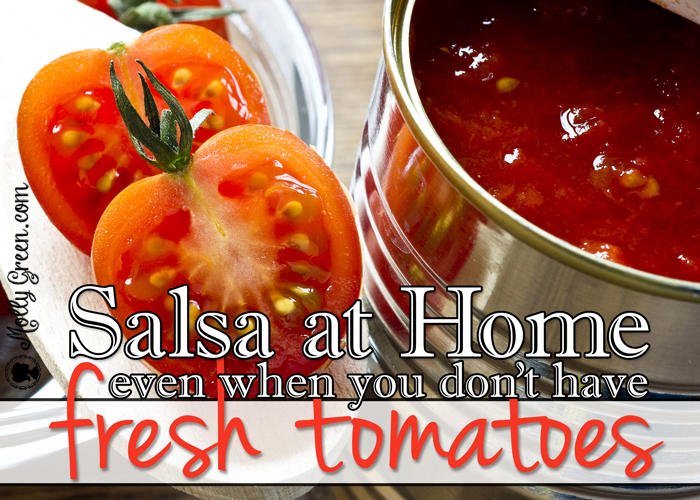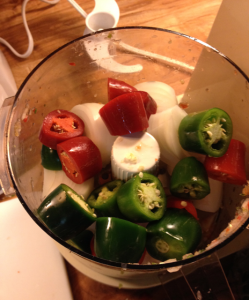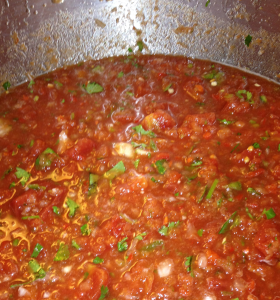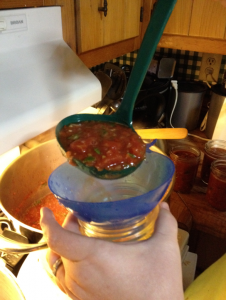By Jan Hatchett
If you were to ask my two sons what their favorite home-canned food was, they would tell you about their mama’s homemade salsa for canning. It is the hands-down favorite for snacks, to add to recipes, and to just perk up some veggies around here. And also, I have to admit, I love to hear the sounds of, “Mmmmm! Do we have any more of this?”
But, I can’t take credit for this salsa prowess. I didn’t grow up eating salsa. I didn’t grow up eating spicy foods at all, unless ketchup is spicy. My wonderful hubby, who is a far better cook than I am, taught me how to make a batch of salsa to go with a meal. He cooked up a batch whenever we wanted some. He learned, in turn, from his mother who was a far better cook than the both of us put together. And she learned from her mother in Mexico.
One thing I began to do early in our marriage was to use a water bath canner to put up tomatoes, peaches, and some jellies. From there, adapting our salsa into a larger batch that could be canned to savor all winter long became a simple thing.
Salsa Recipe Ingredients:
- Fresh garden tomatoes or canned tomatoes. You can blanch and peel fresh tomatoes or just wash thoroughly and pulse in a blender or food processor. We have also had success using #10 grocery store purchased cans of crushed or diced tomatoes in the winter or if our tomato harvest was down. Use crushed tomatoes as they are and grind up diced ones in a blender like fresh. The “brightness” in the taste comes more from the cilantro and lemon juice than the tomatoes themselves, as they provide only the background for this tasty dip!
- Fresh peppers. All are good; just watch the heat. We use jalapenos, habaneros, serranos, cayenne, just whatever we have until it tastes good to us. Banana peppers and bell peppers are nice, too, especially if you like a chunky salsa).
- Yellow onions. We were able to get sweet Vidalia onions this year, but use whatever onions you have. Green onions can be nice, too. Fresh if you have it, dried if you don’t. Add to taste or omit if you don’t care for it.
- Add a few minced cloves if you like.
- Salt to taste. I use a tablespoon in a huge stockpot.
- Lemon juice from concentrate.
How to Make Salsa for Canning:
The process is simple. There are no hard and fast measurements. We start with whatever volume of crushed tomatoes will work in our pan and add other ingredients until the taste is right. Crush the tomatoes if using fresh. I use a blender and fill it two-thirds full with tomatoes and then with chunks of the other ingredients. Pour into a large pan, and place it on medium heat while you continue to process the remaining ingredients.
I usually use a large stock pot and make multiple canner loads at once, but this same technique in a blender can make as little as one quart of salsa easily. When your pot is as full as you would like, stir, raise the heat to medium-high and bring it to a boil. Keep stirring. Taste and adjust the seasonings. Bear in mind that the salsa often gets a bit warmer in the jars after processing, so stop just shy of perfect. Let the salsa simmer for 10-15 minutes.
Prepare your hot jars:
To pints, add 1 Tbsp. of lemon juice to each jar to boost the acidity for safer canning. Add 2 Tbsp. per quart. It is not safe to can salsa in half-gallon or gallon-size jars.
Fill hot jars and place a simmered lid on top. Screw lids on finger-tight. Process in your choice of a boiling water bath or pressure canner. Google USDA guidelines for current times and pressures for canning salsa. These rules change from time to time and I would be remiss if I gave you a hard and fast rule that science rules obsolete in a year’s time. I also recommend referencing the USDA Complete Guide to Home Canning.
If you choose to pressure can, be sure to know your elevation above sea level. To find it, Google your city and state with the word “elevation.” If you are at an elevation at or above 1,000 feet, you will need to adjust your canning times.
Finally, keep the salsa hot between canner loads and make sure it is at a good simmer when you add it to hot jars for subsequent batches.
Tips for handling hot peppers:
The heat from peppers comes from the seeds and membranes. Consequently, you can leave them in if you like it hot and you can remove them for a milder salsa. Wear gloves, or only handle the stems and the intact parts of the skin. After handling, wash hands thoroughly with soap and a couple of tablespoons of baking soda to neutralize any of the acids that may remain on the skin.
Tips for cooking with hot peppers:
Always add peppers slowly and judiciously. Let this cook for a minute, stir the food thoroughly, then taste. It is far easier to add more heat than to take it away.
Homemade Salsa for Canning – Troubleshooting
Is your homemade salsa for canning too hot? Mix full-fat sour cream or cheese into the salsa. The fats encapsulate the molecules that create heat in your mouth (it’s actually a weak electrical charge) and keep down the burning sensation.
Salsa too mild? Maybe add more peppers when serving (pickled jalapenos are good) or a little of a good cayenne-based hot sauce or sriracha.
Has this homemade salsa for canning put your mouth on fire? Quick, grab either some full-fat milk, a carbonated beverage, or beer. All of these drinks act to prevent the electrical activity in your mouth from building to a painful pitch.
Jan Hatchett is a Christian wife and homeschooling mother to two handsome sons. When not quilting, canning, crafting, sewing, canning, gardening, cooking, or horseback riding, she describes her exploits at www.anotherhatchettjob.wordpress.com.
(Hooked on using fresh tomatoes? You won’t want to miss our article on how to start tomato plants!)









1 thought on “Homemade Salsa for Canning even without fresh tomatoes”